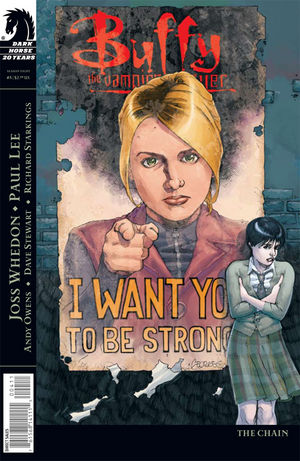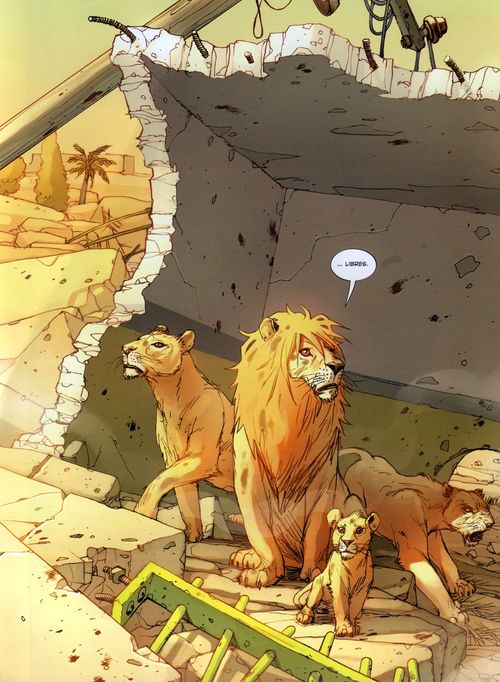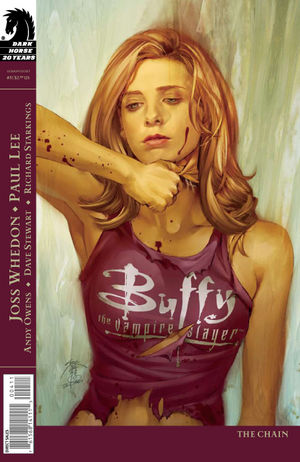
Writer: Joss Whedon
Cover Artist: Georges Jeanty
Penciller: Paul Lee
Inker: Andy Owens
Colorist: Dave Stewart
One-shot issues are the quickie of the comic book medium. And, like its sexual counterpart, the one shot can be incredible and mind-blowing, or - more often than not - an embarrassing experience best hastily forgotten by all those involved. Buffy the Vampire Slayer No. 5 bounces back and forth between these two poles.
The in-and-out nature of communicating a story in one issue is an unappreciated challenge: On the one hand, the writer has got to show his faithful fans a new angle of familiar material; while, on the other hand, the one-shot affords the writer an opportunity to step out of continuity and reach a new crowd. In this case, the new reader could be (gasp) someone so unfamiliar with the Buffyverse (Joyce forbid!) that they just bought the book because they dug the cover art.
For Buffy buffs, the success of No. 5 hangs, quite literally, by a nose. There is no denying that Sarah Michelle Gellar's most idiosyncratic facial feature is her long, thin nose, which has two very angular pieces of cartilage sitting atop each nostril. BTVS No. 5 presented Paul Lee with a daunting task: To draw a vampire slayer who has gone undercover posing as Buffy that looks enough like Buffy to fool other characters in the story, but also enough not like Buffy that fans know she's not the real Buffster. Lee achieved this by making imposter-Buffy's nose look different. Alas, I didn't catch that imposter-Buffy was not the genuine article until the story revealed the plot twist. I just thought Buffy's nose looked funny. This was a pretty crucial blow to enjoying the book the first time I read it.
And I don't administer that nose note as a criticism of Lee's art. The illustrations in the book are solid. Particularly memorable are the underground creatures, such as the faeries, slug clan ... and who can forget "that thing that looks like a leaf-blower"?
That said, the non-linear storytelling in this issue further confounded the reveal. Whedon seems to vacillate between wanting to spell everything out for new readers, and being flippant with rehashes to keep his fan base satisfied. For example, one sequence jumps quickly among three threads: Imposter Buff (henceforth IB) on her present undercover mission; IB passed out on her high school lawn after the physical trauma of realizing she is a slayer (which involves being hit with the collective memory of a bajillion slayerettes at once - very skillfully illustrated by Lee); and listening to Giles give a speech at the slayer academy. Running over all these panels is some throw-away monologue about what it means to be a slayer. To give him the benefit of the doubt, Whedon likely had too much to say and not enough space to say it, which resulted in some fast-forwarded, over-dramatic build-up with no, ahem, climax.
The few choice moments when Whedon does slows down to assemble the moment-to-moment narrative is when he really woos the reader. These scenes include such stellar quotes as, "I didn't lay my faerie eggs inside your inner ear canal to watch you die!" And let's not forget: "I left you one to wipe with." Perhaps my favorite sequence in the book is Whedon's depiction of a slayer field training session, in which IB and her slayer squad face off with a group of vamps in (where else?) a dark alley. IB's fighting skills aren't flawless and winning her hordes of adoring fans, but she does "take a bite" (from a vamp) while saving a fellow slayer. This poignant vignette captures a truism we all know yet too often forget: It is better to be loved by one person than popular with many. A million fans won through acts of showmanship are worth less than one loving friend acquired through an act of self sacrifice. And self sacrifice is more difficult. When IB disparages her neck wound as the result of her lack of prowess, her friend not only reminds her of this, but also dishes out the clever compliment: "Besides ... I hear Buffy's got a neck wound too." (Can you hear me smiling?!)
So, all in all, for Buffy fans, this one shot does what any good quickie should: keep you coming back for more. The name "Buffy" means something different to every fan, but what all BTVS fans have in common is the knowledge that, as IB so cleverly illustrates in BTVS No. 5, "millions of people go into making a name." BTVS No. 5 gives us a glimpse into the life of one of those millions; one who is ultimately OK with living and dying anonymously. In this era of fame-worship and celebutantes, that is a very stirring idea.
But what about non-BTVS regulars? They may still find the aforementioned heart of the book moving, but maybe not as much as a Buffy fan, to whom the name really means something. Although it may not appeal to every comic book fan, I think there are enough enticing story angles to compel certain persons of discerning and unusual taste - those who like their entertainment to have a heart and a lesson plan - to return for another round.



